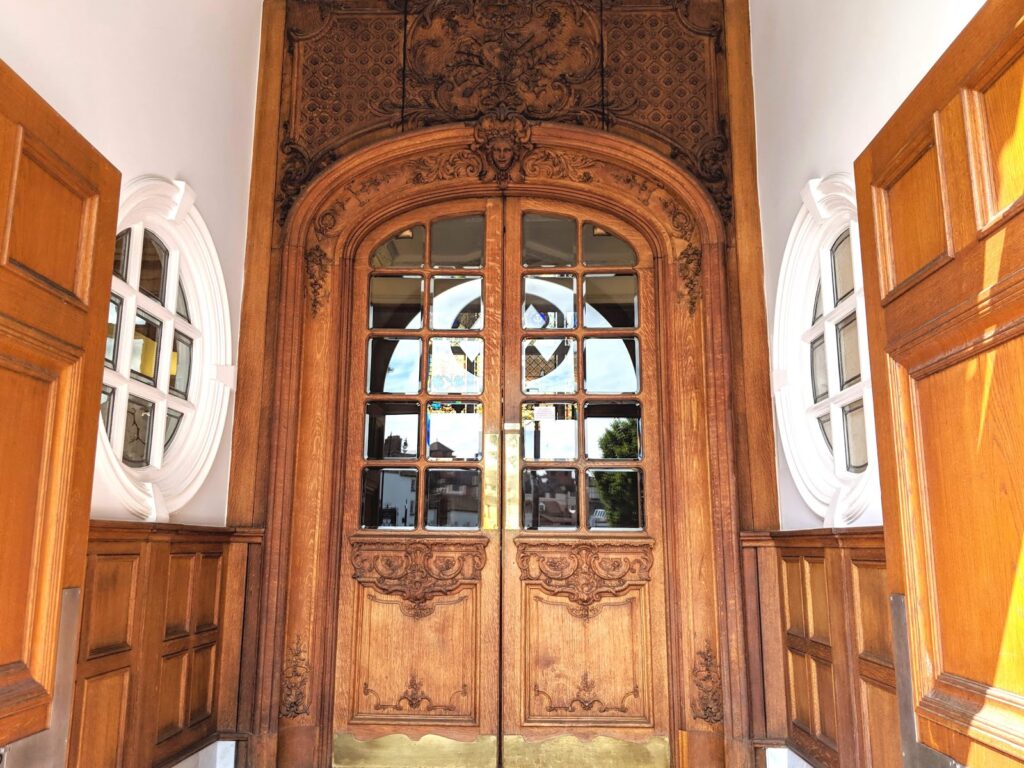THE LEGACY OF THE HMHS BRITANNIC

The doors as seen today at Morris & Co. The doors can be viewed at: Morris & Company Welsh Bridge, Shrewsbury, SY3 8LH
Text and Images kindly provided by Morris & Co.
The doors create the elegant front entrance swing doors to our head office building here at Welsh Bridge in Shrewsbury. These carved doors were purchased in Birkenhead by James Kent Morris, the son of the company founding family member who set up Morris’s in 1869. James Kent II was travelling up to Liverpool to sell his specialist oils when he saw and purchased the beautifully carved matching saloon doors.
It has always been believed that these doors were originally destined for an ocean liner due to their intricate detailing. In fact, there is a piece of wreckage at a Titanic display at the Ocean Liner Exhibition at the V&A. It is the same design as the panel above our double doors.
Sean Szmalc, an ocean liner enthusiast and fellow enthusiast Paul Barker came to see the Morris doors in 2019 and confirmed that these are identical to those found in the first-class lounge on the Titanic. It seems conclusive therefore, that the Morris doors were hand carved to be fitted onto the Titanic’s sister ship, The Britannic, but were never used. The Britannic was the 3rd sister for the Olympic and Titanic ships.
The doors found their home on Morris’s Queen Anne style building which was completed by the company in 1922 and have been an eye-catching feature ever since. Two sets of the doors were originally purchased and a second single door was put into storage. Another nice element to the story is that when we extended our head office in 2008 to wrap around the corner we needed a second entrance and went to our storage and found the matching carved door in pristine condition having been very carefully braced and stored for over 70 years. So, these are also now pride of place on another elevation of the building.
We are proud that these doors have become a unique landmark in Shrewsbury having been part of the Morris family for so long.
Carved wood is a really strong feature within our business and it features internally throughout our three-storey head office building. Today we have a bespoke Joiners Workshop nearby which not only restores our own wooden architecture but provides handcrafted joinery for our Property business and many of its other clients who still value the quality of traditionally crafted woodwork.
Our Joinery team are also proud this year to have been awarded a prestigious commission with Historic England to restore and replace 39 windows at the town’s historic Flaxmill Maltings, known as the grandparent of the modern skyscraper.

THE LEGACY OF BRITANNIC'S ORGAN
Researchers at the Museum of Music Automatons in Seewen are confident that they have discovered the long-lost organ of the Britannic – the sister ship of the ill-fated Titanic, which sank on its maiden voyage in 1912.
The instrument, which is documented in drawings and a photograph, had been missing for nearly a century. It was unearthed during the restoration of the Welte philharmonic organ belonging to the Museum of Music Automatons.
Dr. Christoph E. Hänggi, Director of the Museum, explains: “The organ builders were cleaning three areas under the soundboard of the organ that are not normally accessible, and found three identical stamped marks reading “Britannic”.
“We’d actually always believed that our Welte philharmonic organ must have been made between 1912 and 1914, but we had no evidence of its history prior to 1920. Although the historical Welte catalogues in our academic archive contained a photograph of an organ in the stairway of the Britannic, we had never remotely considered that it could be our organ.”
The Britannic organ in Seewen is a variant of the base model V-VI of the Welte Philharmonic organ with a dual console and pedal as well as a roll mechanism for automated play. During restoration of the organ at the end of March 2007, an inscription was found stamped on one of the off-note motors that pointed to the organ’s original purpose. While cleaning normally hidden beams, the word “Britanik” was stamped on four different locations on the original organ. Additional inscriptions were found at the end of May 2007 brining the total inscriptions found to six. The organ was intended for the ocean steamer Britannic – the sister ship to the Titanic. This type of organ was documented for the ship, but had been considered lost until recently.
The organ was never installed, since the Britannic was sunk during the First World War in 1916. The Welte company therefore sold the organ in question to Dr. August Nagel (1882-1943) and installed it at his residence in Stuttgart. Nagel had owned a highly successful camera manufacturer since 1908 and loved music.
Nagel returned the organ to the manufacturer in 1935 since he sold his house. Once again, the Welte company found another buyer and sold the instrument in 1937 to Dr. Eugen Kersting (1888-1958), owner of the electronics company Radium in Wipperfürth. Dr. Kersting had the instrument installed in a reception room with some additions. Werner Bosch (1916-1992), a German organ builder, was assigned to maintain the organ.
Finally, Heinrich Weiss, the founder of the Museums for Musical Automatons became aware of the instrument and purchased it in 1969 for his already considerable collection. After moving the instrument to Switzerland, Weiss invested some 1,500 hours installing the organ and commissioned Werner Bosch to do the final regulation. The re-inauguration of the organ was celebrated on May 30, 1970 in Seewen. Bosch was himself so impressed by the collection in Seewen as well as the rescue of “his” Welt Philharmonic, that he brokered the acquisition of 1,230 original rolls that came into his possession from the Welte company inventories. Now, the Museum for Music Automatons Seewen not only has an exceptional instrument with its exceptional history, but it also possesses the corresponding original recordings for its collection.
The organ designated as the sister instrument of the also well-maintained and restored Welte Philharmonic Organ at the Salomon Center in Tunbridge Wells, England.
Author Credit: Museum Fur MusikAutoMaten Seewen So.

